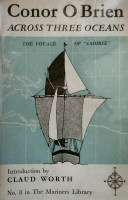Edward Conor Marshall O'Brien
Edward Conor Marshall O'Brien (3 November 1880 – 18 April 1952)[1] was an intellectual, Irish aristocrat, republican, nationalist, pioneer in modern maritime theory, owner and captain of one of the first boats to sail under the tri-colour of the Irish Free State. He was born in England. He was well educated, being able to read and write in both English and Irish. He was a grandson of the Fenian William Smith O'Brien. He was a ship builder/designer and his notable boats include the Kelpie (used for gun running in 1914), the Saoirse (in which he circumnavigated the globe) and the A. K. Ilen (a Falkland Islands service ship, undergoing restoration).
Early life
Edward Conor Marshall O'Brien was born in Limerick on 3 November 1880. His grandfather was William O'Brien who was a member of Young Ireland. Social reform was in his family as his grandfather and aunt having roles to play in it. His aunt was Charlotte Grace O'Brien. Robert Donough was his uncle who was an architect, and his brother was a painter called Dermod O'Brien. He was educated in England in Winchester College and Oxford and in Ireland in Trinity College.[2] After education he came back to Ireland and starting practicing as an architect in 1903. According to the 1911 census he live at 58 mount street south Co.Dublin.[1]
Architect
O'Brien was credited with two buildings in his lifetime. One was the Co-operative Hall in Co. Donegal and the other was the People's Hall in Co. Limerick.[3] These buildings are still in use today even though they were built in 1908 and 1914. he was also known as a naval architect as he designed two ships, the Saoirse and the llen. He would later captain both of these ships and show great success as a captain.
Across Three Oceans

O'Brien's boat Saoirse was reputedly[4] the first small boat (42-foot, 13 metres long) to sail around the world, a journey that he documents in his book Across Three Oceans. O’Briens voyage began and ended at the Port of Foynes, County Limerick, Ireland, where he lived.[5]
Saoirse, under O’Brien's command and with three crew, was the first yacht to circumnavigate the world by way of the three great capes: Cape Horn, Cape of Good Hope and Cape Leeuwin; and was the first boat flying the Irish tri-colour to enter many of the world's ports and harbours. He ran down his easting in the Roaring Forties and Furious Fifties between the years 1923 to 1925. Up until O’Brien's circumnavigation this route was the preserve of square-rigged grain ships taking part in the grain race from Australia to England via Cape Horn (also known as the clipper route).
O'Brien's claim is contentious as Joshua Slocum, a Bostonian, was the first single-handed yachtsman to successfully pass this way (in 1895). However, extreme weather forced him to use some of the inshore routes between the channels and islands of Cape Horn and it is believed he may not have actually passed outside the Horn proper. Nevertheless, the scale of Slocum's achievement is not dininished by this technicality.
Slocum and O'Brien's pioneering circunavigations by small cruising yachts were to be a precursor of the 1968 Sunday Times Golden Globe Race, the 1972 Whitbread Round the World Race and today's very popular and professional global event the Volvo Ocean Race.
Restoration of the Ilen
O'Brien's seagoing experiences were put to use in his design of the A K Ilen which was built for the Falkland Islands as a service boat. In 1998 the Ilen returned to the site where it was first built, on the river Ilen near Baltimore in south-west Ireland, where it is currently undergoing a full restoration (expected to be compled by 2017). This task provides work-based learning for the students of the Ilen School.
Gun running
O'Brien had some involvement with gun running in 1914 on behalf of the Irish Volunteers. This was due to his political views and because he had past experience in sailing. O'Brien was in favour of home rule in Ireland at the time. Due to this he joined the Irish Volunteers. This was on the boat the Kelpie. He did this with George Mallory and Winthrop Yount. On 26 July 1914 900 guns were brought to Howth harbour .[6] Also he was involved in bringing guns to Kilcoole beach on the Wicklow coast. After the gun running O'Brien served in the Royal Naval Volunteer Reserve.[7]
Publications
O'Brien authored a number of books which document his experiences of sailing - from which he distills advice for other boat designers, builders and sailors - which appear in his books. He also wrote novels on the nautical theme.
Non-fiction
- Across three oceans
- From three yachts - a cruiser's outlook
- The small ocean-going yacht
- Yacht gear and gadgets
- Sea-boats, oars and sails
- The practical man's cruiser
- On going to sea in yachts
- Deep-water Yacht
- Deep-water yacht
- Sea-boats, oars and sails
Fiction
- The Castaways
- Two Boys go Sailing
Sources
- O'Brien, Conor (1926). Across Three Oceans. London: E.Arnold. ISBN 0-246-12309-5.
- Hill, Judith (2009). In Search of Islands, A Life of Conor O'Brien. Cork: The Collins Press. pp. viii, 126. ISBN 9781905172658.
- de Bhaldraithe, Padraic (1996). Loingseoir na Saoirse - Scéal Conor O'Brien. Baile Átha Cliath: Coiscéim.
- Life and ships of Conor O'Brien - documented on the A K Ilen restorer's website.
- Conor O'Brien: Life, Works, Criticism, Notes
- Foynes Yacht Club - History (paragraph 2 on Conor O'Brien and the Saoirse)
References
- 1 2 http://www.census.nationalarchives.ie/pages/1911/Dublin/South_Dock/Mount_Street__Upper/85222/
- ↑ Ilenhttp://www.ilen.ie/what-we-do-2/ilen/ilens-history/
- ↑ http://www.dia.ie/architects/view/4061/O'BRIEN-EDWARDCONORMARSHALL#tab_works
- ↑ Holm, Donald (Don) (1974). The Circumnavigators: Small Boat Voyagers of Modern Times (Chapter 7). New York: Prentice-Hall. pp. xvi, 496. ISBN 0-13-134452-8.
- ↑ http://www.limerickleader.ie/what-s-on/features/o-brien-rode-wave-of-history-1-2187987
- ↑ http://www.ilen.ie/what-we-do-2/ilen/the-gun-runner-1914/
- ↑ http://discovery.nationalarchives.gov.uk/details/r/D7718929